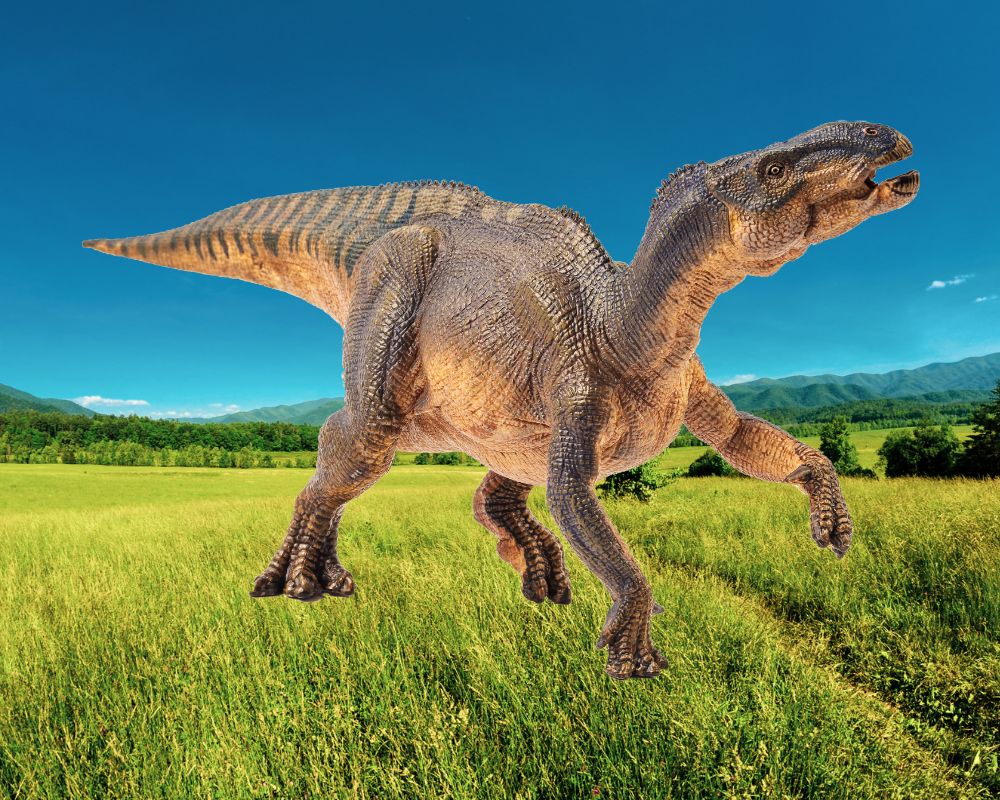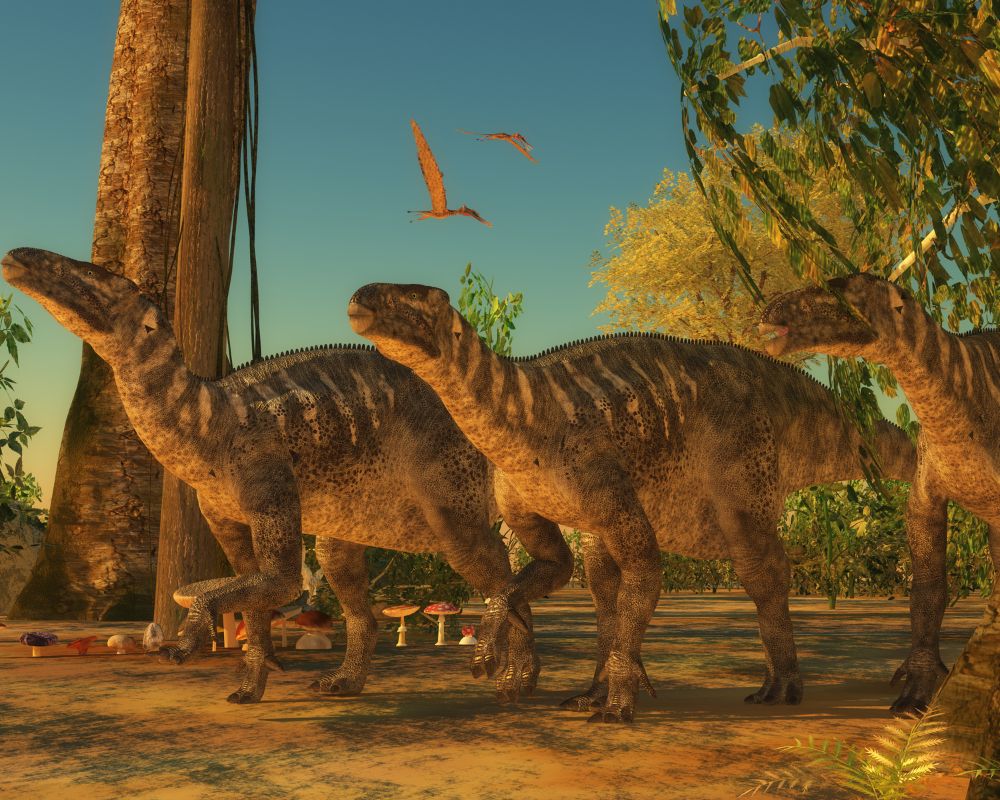The Iguanodon was a giant herbivorous dinosaur that lived in forests and grasslands of the Cretaceous period. With a unique jaw equipped to grind plants and twigs and cheek pockets, this dino spanned most continents, from North America to Asia.
Table of Contents
Some Quick Facts About the Iguanodon

| Name | Iguanodon bernissartensis, “iguana tooth” |
| Type of dinosaur | Iguanodontidae, ornithopoda |
| Territory | Grasslands and marshes of North America, Europe, North Africa, and Asia |
| Size | Medium-sized, 30 feet long, 9 feet tall, 8,000 pounds |
| Color | Brown and green |
| Interesting Characteristics | It was one of the first dinosaurs discovered. it could move its jaw up and down and left and right |
| Diet | Plant material |
| Major Threats | Larger carnivorous dinosaurs |
The Iguanodon was a widespread ornithopod that roamed much of the Earth during the late Jurassic to early Cretaceous period. It was one of the first dinosaurs ever discovered, along with the Megalosaurus, and paved the way for paleontology.
What Is The Meaning Of Iguanodon?
“Iguanodon” means “iguana tooth” because paleontologists believed the tooth belonged to an iguana, not a dinosaur. When Gideon Algernon Mantell found the Iguanodon teeth in 1822, dinosaurs weren’t an established species yet.
It was one of three dinosaurs to create the Dinosauria category of extinct creatures. That’s what makes the discovery of the Iguanodon so important!
How Big Was The Iguanodon?
The Iguanodon was a very large herbivorous dino of the early Cretaceous period. It measured 30 feet long, although some Iguanodon fossil remains measured up to 43 feet long! It stood around 9 feet tall and weighed about 8,000 pounds. If a full-grown human bumped into a friendly Iguanodon at the park, they would come up to its thigh.
Did Iguanodon Walk On Four Legs?

The Iguanodon had very short forelimbs, but it could sometimes walk around on all fours. Most of the time, the Iguanodon walked around on four legs, sometimes on two.
Paleontologists believed that the Iguanodon was quadrupedal, which means it walked around on four legs. However, as they discovered more bones, they determined that the Iguanadon was bipedal or walked around on its hind legs.
What Was The Purpose Of Its Thumb Spike?
The Iguanodon needed protection as an herbivore living with serious apex predators like the T. Rex. It used its deadly thumb spike to protect itself from predators.
Putting together dino fossils is like putting together a puzzle with no picture. At first, paleontologists placed the thumb fossil on its head like a horn. However, they soon discovered that it wasn’t a horn but a long thumb spike.
What Did The Iguanodon Eat?

The Iguanodon was a herbivore and mainly lived on plants. What’s interesting about the Iguanodon is its unique jaw, which makes it easier to crush leaves and twigs in its mouth. It could move its jaw up and down and side to side to grind plant material like ginko.
Paleontologists also believe that the Iganaodon had cheek pockets to hold onto food in its mouth. While paleontology doesn’t know what that Iguandodon ate, they understand that the structure of its teeth was perfect for plants and not meat.
What Was The First Iguanodon Fossil Discovered?
The first Iguanodon fossils found were its teeth in Sussex, England, in 1822 by Gideon Mantell. In the early 1800s, the dinosaur genera hadn’t been classified in the animal kingdom. The first fossils found in England were considered giant iguanas or large crocodiles.
It wasn’t until more fossil records appeared that the discovery of giant extinct creatures was announced. The Iguanodon, Megalosaurus, and Hylaeosaurus paved the way for the entire field of paleontology.
Did Iguanas Come From Iguanodons?
Iguanas did not evolve from Iguanodons. It sounds confusing, but the Iguanodon is a completely different type of creature. It earned its name because, at first, paleontologists believed that the fossils unearthed in England were that of a giant iguana and gave it the name Iguanodon.
However, they soon learned that the Iguanodon was a species of ornithopod of the late Cretaceous, distinct from modern-day Iguanas. Modern-day iguanas may look like tiny dinosaurs but did not evolve from giant pre-historic dinosaurs like the Iguanodon.
What Is The Closest Relative Of The Iguanodon?
The closest relative to an Iguanodon isn’t an iguana but hadrosaurs or duck-billed dinosaurs. The Iguanodon is closely related to dinos, such as Dryosaurus, Edmontosaurus, Camptosaurus, and Ouranosaurus.
They had a similar set of teeth, perfect for chewing plants, and were of similar size with strong back legs and smaller forelimbs.

